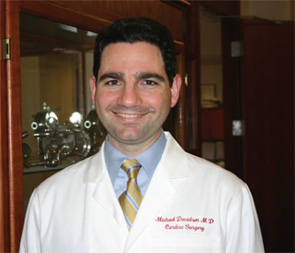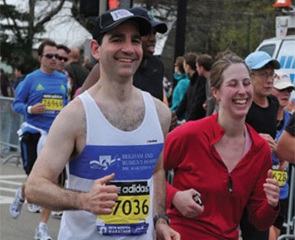Tuesday, Jan. 20, a busy morning lay ahead for the staff of the cardiovascular surgery clinic. There were several new patients to see. No doubt, many of them were anxious to hear whether the skills of the surgeons they were going to meet could help them live another day. There were countless follow-up visits and postoperative wound checks to perform. And of course, the mundane, mind-numbing, time-robbing tasks of 21st century medicine awaited them, too—the drudgery of completing prior authorizations for prescriptions, haggling with insurers to approve appropriate care and having to click endlessly through a maze of electronic health records (EHRs). It’s always a challenge to stay on course and on time in a busy clinic, especially for some of our surgical colleagues who have a tendency to attempt to defy the laws of physics that govern time and space by wildly overbooking their sessions. A dear orthopedic colleague advises new patients to “bring a thick Russian novel to read,” because their wait times may run several hours. War and Peace, anyone?
One particular cardiovascular surgeon working on this particular day did not exactly fit the surgeon’s stereotype. By all accounts, not only was he talented, thoughtful and caring, but he respected the time constraints of his patients. So when the son of a patient whom he had recently operated on arrived unexpectedly at his clinic demanding to speak with him, he set aside time later that morning to meet.
The patient was an elderly woman with a history of cardiovascular disease, emphysema and two prior heart valve surgeries in need of further valve repair. Many surgeons would have considered her far too frail to submit to additional surgery. Yet Mike Davidson, MD, had acquired a reputation as a brave surgeon who was willing to operate on the riskiest patients and who achieved a remarkable degree of success in the operating room. He was beloved for his bedside manner and for his willingness to talk patients’ families through the intricacies of surgery, no matter how long it took.1
Three months earlier, the woman’s surgery had gone well enough that she was discharged to a rehabilitation facility to be closer to her home and family in central Massachusetts. However, her health had declined, and her son, who served as her healthcare proxy, called Mike seeking his advice. Mike reviewed her medical management at the facility and concluded that she was receiving the appropriate care. However, over the course of the next few weeks, her condition worsened. At the family’s request, she was taken off life support in mid-November and passed away a short time later.
This sad turn of events had prompted this day’s visit. Mike, along with one of the physician assistants working with him, and the patient’s son squeezed into the tight space of Exam Room 15 in the Watkins Cardiovascular Clinic at the Brigham and Women’s Hospital in Boston. According to witnesses, the son seemed angry but never raised his voice. He began by insisting that Mike look up the toxicity profile of amiodarone, one of several drugs that his mother had been prescribed following her surgery. Based on his personal interpretation of the data available online, the son had concluded that this drug killed his mother.
No one expects to face a killer within the confines of a hospital.
“You did not tell me or my family the detrimental side effects of this drug, and my mother’s dead because of this,” he said.2
Although Mike disputed this assertion and tried to reason with the son for the next 40 minutes, nothing he said would placate the son. Realizing that he was falling woefully behind schedule, Mike stood up and started to leave the room, having asked the physician assistant to depart several minutes earlier.
A patient and his father waiting in the exam room next door recalled hearing the sound of a table sliding on the floor followed by the sound of three gunshots. The first hit Mike in the thigh and the second in his back. He burst out of the room shouting, “Run, run, he’s shooting; he’s shooting!” before collapsing to the ground. Then came the blast of the third bullet, piercing the skull of the shooter: a death by suicide.
The cardiovascular operating rooms are situated a mere three floors below the site of the carnage, a quick descent on the hospital elevators. Despite an exhaustive effort spanning 11 hours, Mike could not be rescued, leaving his young family shattered in the wake of these two bullets. His wife, Terri, was seven months pregnant. She gave birth to their fourth child, Mikaela Jane Davidson, on April 4, 2015. Terri and their four young children survive him.
Sadly, Mike’s near-final words, uttered to a colleague as he was about to meet the son, presaged the outcome: “Watch this, he’ll probably shoot me.”2
The Doctor as Target
No one expects to face a killer within the confines of a hospital. I hope that I never again hear the voice on the hospital loudspeaker system imploring patients to “seek immediate cover. Active shooting incident on Shapiro 2.”

Dr. Mike Davidson.
Fortunately, these terrible events are relatively rare in the United States, a country with no shortage of guns. One study tallied 154 hospital-related shootings between 2000 and 2011; physicians were victims in 3%, and nurses were targeted in 5%.3 The most common site for medical violence was the emergency department (ED), often a portal of entry for street crime into inner-city hospitals. A survey of ED doctors in Michigan reported that 28% of respondents had been physically assaulted in the previous year.4 However, data from the U.S. Bureau of Labor Statistics suggest that the incidence of homicides at hospitals is similar to the rate observed in lawyers’ offices and lower than the rates in hotels, real estate offices and government workplaces.3
The story is quite different in China, a country where medical workplace violence is a growing concern. It’s estimated that patients injure approximately 10,000 medical personnel every year. A recent article in The New Yorker recounted a two-week period in 2012 when angry patients paralyzed a nurse in Nanjing, cut the throat of a doctor in Hebei and beat a Heilongjiang doctor to death with a lead pipe.5 The piece detailed the sad story of a 17-year-old boy from Inner Mongolia suffering from ankylosing spondylitis (AS) who experienced a miraculous improvement after starting treatment with infliximab, only to have the drug discontinued after he developed tuberculosis. Not surprisingly, his AS symptoms began to flare dramatically. His doctors were circumspect about their next course of action, preferring to communicate with the patient’s grandfather rather than with the patient himself. Outraged that his therapy was placed on an indefinite hold, he returned to the hospital, approached the first white coat he saw and plunged a 3″ knife deep into the wearer’s neck, killing the medical resident instantly.
According to our colleague, Qiang Tong, MD, a rheumatologist at Changhai Hospital in Shanghai, China, there are several factors underpinning this perilous work environment, including enormous patient caseloads that limit the time available for each patient, the inequitable distribution of healthcare resources in China and the high cost of most treatments.6
Dr. Tong described a novel approach being promoted by the Chinese Rheumatology Information System that attempts to improve upon this dismal state of affairs.Using a newly developed set of diagnostic and therapeutic data, these rheumatologists aim to standardize treatment for all lupus, rheumatoid arthritis and scleroderma patients by providing well-researched, evidence-based treatment protocols and, thus, assure a more equitable distribution of medical resources in the cities and the rural areas of China. Perhaps by creating a degree of transparency, patients may be dissuaded from resorting to violence when optimal clinical outcomes are not achieved.
Mourning a Death
In the weeks following Mike’s murder, a number of revelations emerged surrounding the shooter. We learned that he had a checkered past, harbored some deep personal grudges and had an unshakable belief in his own righteousness.2 Over the years, financial issues seemed to be a source of considerable stress. In 2011, he wrote to his congressman on behalf of his mother, complaining about an $8,000 medical bill incurred from a fatal heart attack that his father suffered, commenting, “I’m certain that Medicare is being overcharged thousands of times a day by hospitals that will have great difficulty justifying the costs they are passing on.”7

In 2010, Dr. Davidson ran the Boston Marathon with Team Brigham to celebrate his 40th birthday.
According to a person who examined the thumb drive files that the son left behind, he laid out his research on amiodarone and concluded that Davidson was responsible for his mother’s death. “Not solely,” he wrote, but “the majority.” He concluded by saying, “The doctor is dead. I am dead. There is nothing more anyone can do.”2
He was on a mission that cold January morning. The heavyset man with the expressionless face, wearing khaki pants and a black ski jacket wandered through the hospital for over an hour, his trail recorded by the multiple security cameras planted throughout our facility. Analyzing his trail and timeframe, there was a possibility that we crossed paths in one of the busy walkways leading to the cardiovascular clinic. What was on his mind during the hour before his arrival at the clinic? Was he having second thoughts about killing the doctor? Was Mike his only enemy, the sole target of his rage? Or was he contemplating killing more people to avenge his mother’s death?
We live in a world where acts of violence are commonplace, and some have started to encroach upon areas that were previously considered to be immune to mayhem and madness.
Shortly after this horrific day, the long-awaited trial of the Boston Marathon bombing suspect began. The jurors were shown hours of surveillance videotapes that readily identified the suspect and his brother placing their backpacks on a downtown sidewalk, right next to a lovely family, a mother, a father, a young boy and a girl. They were soaking up the sun, enjoying the festive mood at the finish line. Just as Mike could not realize that his meeting with the son would turn tragic, the Richard family had no idea that the innocuous looking backpack placed on the sidewalk next to them concealed a jury-rigged homemade bomb, set to explode and kill their son, maim the mother and daughter and scar them forever. What senseless death and destruction.
Could any of these terrible tragedies have been prevented? The security cameras placed outside a department store on Boylston Street near the marathon finish line were able to record those horrible minutes leading up to the explosion and, ultimately, provided the critical clues that identified the perpetrators. Similarly, the hospital cameras could trace the comings and goings of the shooter, but they could not forewarn the staff of an imminent danger.
Should metal detectors be installed at hospital entrances? Should patients be frisked for weapons? They are some of the suggestions being offered, but frankly these cumbersome procedures are impractical for hospitals and especially for smaller clinics and offices.
The adverse effects of therapy, the gloomy prognosis of many diseases and the high cost of healthcare create enormous stresses for some patients and their families. Not every medical story has a happy ending. There have been times when some of us have felt physically threatened by disturbed patients or their family members. We are all vulnerable. Through a simple twist of fate, we could face an angry son bent on exacting sick revenge. After all, as caregivers, we represent the face of healthcare, and sometimes that face is far from pretty. And when a colleague is killed in the line of duty, we have a right to be angry, sad and scared.
Medicine is a healing art, not a violent vocation, and when bad things happen to good people, we must find the strength to forge ahead and not be deterred from our mission to make people’s lives better.
 Simon M. Helfgott, MD, is associate professor of medicine in the Division of Rheumatology, Immunology and Allergy at Harvard Medical School in Boston.
Simon M. Helfgott, MD, is associate professor of medicine in the Division of Rheumatology, Immunology and Allergy at Harvard Medical School in Boston.
References
- Rosenbaum L: Being like Mike—fear, trust, and the tragic death of Michael Davidson. N Engl J Med. 2015 Feb 26;372(9):798–799.
- Allen E. Fury entered here. Boston Globe. March 8, 2015.
- Kelen GD, Catlett CL, Kubit JG, et al. Hospital-based shootings in the United States: 2000 to 2011. Ann Emerg Med. 2012 Dec;60(6):790–798.
- Kowalenko T, Walters BL, Khare RK, et al. Workplace violence: A survey of emergency physicians in the state of Michigan. Ann Emerg Med. 2005 Aug;46(2):142–147.
- Beam C. Under the knife: Why Chinese patients are turning against their doctors. The New Yorker. 2014 Aug 25.
- Tong Q. Speak Out Rheum: Attacks against healthcare providers in China spur Chinese rheumatologists to heal strained doctor–patient relationships through technology. The Rheumatologist. 2013 Sep;7(9).
- MyFoxBoston.com. Investigators still searching for motive in Boston hospital shooting.


